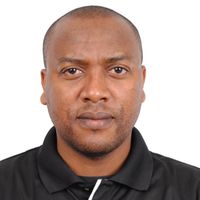
Nashon Adero, a geospatial expert, during the interview at the Nation Centre on June 21, 2021. PHOTO | DIANA NGILA | NMG
In the past five years, Kenya has increasingly turned its focus on the potential of the long dormant mining sector as the country continues to look for ways of diversifying its export portfolio and creating new jobs.
This drive has made it necessary to improve the way the country maps its resources—and land in general— while ensuring that the environment is protected and restored as much as possible after mining activity.
To do this, experts have been applying the latest geo-mapping technology, combining traditional mapping and surveying methods with modern information technology to process imagery and come up with better interactive maps.
This field known as geomatics has already been applied in the real world through the recently launched Ardhisasa platform at the Ministry of Lands and the online mining cadastre portal at the Ministry of Petroleum and Mining.
According to Nashon Adero, a geospatial expert and lecturer of mine surveying at Taita Taveta University, the benefits of better mapping techniques are both commercial and social— enhancing the economic potential of the country while protecting the rights of landowners, the community and the environment.
He says more accurate mapping and the ability to incorporate data into maps that for instance shows ownership history, mineral profiles and legal status is key going forward.
“To achieve the much-needed transparency and data integrity in the mining sector as aspired to in the Africa Mining Vision and similar national development visions, geomatics is a key provider of the accuracy and precision needed for administering land, mining and environmental rights across mining regions,” says Mr Adero.
“This is a crucial contribution to resolving the problems of land dispossession and disputes and the deprivation that thrives in a lack of data integrity and transparency.”
He adds that the modern techniques are embedding data in maps that can now allow users “to go back in time remotely and project into the future,” which will be critical in resolving historical injustices and doing predictive planning to serve future land needs of a community.
For example, by clicking on any given mineral block on the mining cadastre map on the ministry of mining website, one is now able to see the name of the concession holder, the licence application grant and expiry dates, the type of minerals within the block and the area of the block.
Similar attributes will be applied to normal land maps going forward, Mr Adero adds, on platforms such as Ardhisasa.
Here, geographic information system (GIS) data can be used to create immersive maps that contain land ownership details, very accurate boundary delineations, planning and development permits and rights.
GIS uses location-based data collected via satellites, paper maps, and directly from the field through mobile positioning devices to map out resources for analysis and decision-making.
Advanced mapping software also clearly shows where one has cropland, town centres and built up areas, water bodies and forest cover, and go further by showing a 3D layout of the land’s topography in case of future restoration needs.
This is already being put into practice in Vihiga County—whose governor Wilber Ottichilo is a space technologies and GIS expert—which in 2018 said it would deploy GIS technology to efficiently manage its resources such as forests, water, farmlands, minerals, wildlife and wetlands.
All these features have different signatures when one does remote sensing using either satellite or drones, and therefore their changes over time can be accurately plotted and remedial measures taken where there is a deterioration.
This technology would also be deployed by the county to develop spatial plans, land management information and enhance various social amenities such as schools, hospitals and dispensaries, markets, recreational parks and police stations.
However, in order for these new advances in mapping to be effective, the country needs to ramp up the number of skilled experts in the field of geomatics.
Currently, the Institution of Surveyors of Kenya (ISK), which is the professional body registering geomatics experts, has a membership of almost 4,000, but a majority of these experts are in the other survey fields such as land survey and valuation and property management.
Kenyan institutions such as the University of Nairobi, Technical University of Kenya, JKUAT, Dedan Kimathi University and Taita Taveta University are however now offering degree programmes in geomatics, although numbers still remain low compared to other sciences.
“Graduates from these geomatics programmes in Kenya have for a long time been fewer than graduates from most STEM programmes, usually less than 35 per university annually,” says Mr Adero.





No comments :
Post a Comment